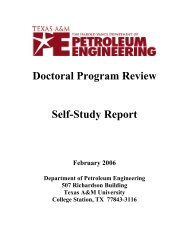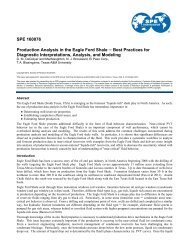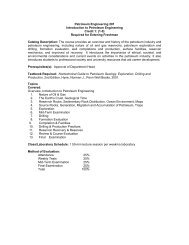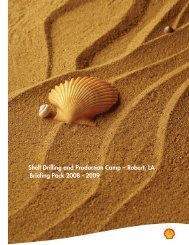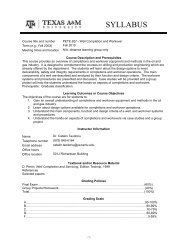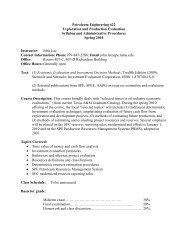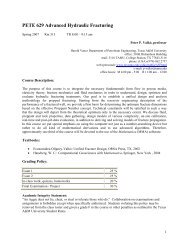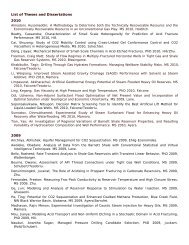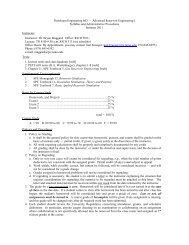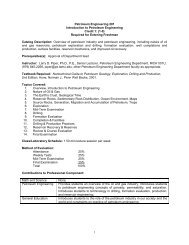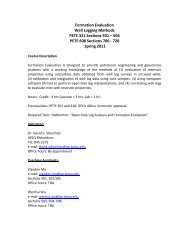Crisman Annual Report 2009 - Harold Vance Department of ...
Crisman Annual Report 2009 - Harold Vance Department of ...
Crisman Annual Report 2009 - Harold Vance Department of ...
Create successful ePaper yourself
Turn your PDF publications into a flip-book with our unique Google optimized e-Paper software.
Measurement <strong>of</strong> Gas Viscosity at High Pressures and High Temperatures<br />
Introduction<br />
Gas viscosity is an important fluid property in<br />
petroleum engineering due to its impact in oil<br />
and gas production and transportation where it<br />
contributes to the resistance to the flow <strong>of</strong> a fluid<br />
both in porous media and pipes. Although this<br />
property has been studied thoroughly at low to<br />
intermediate pressures and temperatures, there is a<br />
lack <strong>of</strong> detailed knowledge <strong>of</strong> gas viscosity behavior<br />
at high pressures and high temperatures (HPHT) in<br />
the oil and gas industry.<br />
The need to understand and be able to predict<br />
gas viscosity at HPHT has become increasingly<br />
important as exploration and production has moved<br />
to ever deeper formations where HPHT conditions<br />
are more likely to be encountered. Knowledge <strong>of</strong><br />
gas viscosity is required for fundamental petroleum<br />
engineering calculations that allow one to optimize<br />
the overall management <strong>of</strong> an HPHT gas field and<br />
to better estimate reserves. Existing gas viscosity<br />
correlations are derived using measured data at low<br />
to moderate pressures and temperatures, i.e. less<br />
than 10,000 psia and 300°F, and then extrapolated<br />
to HPHT conditions. No measured gas viscosities at<br />
HPHT are currently available, and so the validity <strong>of</strong><br />
this extrapolation approach is doubtful due to the<br />
lack <strong>of</strong> experimental calibration.<br />
Objectives<br />
The National Institute <strong>of</strong> Standards and Technology<br />
(NIST) has developed a computer program that<br />
predicts thermodynamic and transport properties<br />
<strong>of</strong> hydrocarbon fluids, which allows comparison<br />
<strong>of</strong> its values with those from correlations and<br />
gives an insight into the current understanding <strong>of</strong><br />
gas viscosity correlations. Note that Viswanathan<br />
modified the Lee, Gonzalez, and Eakin correlation<br />
by using NIST values. The above review <strong>of</strong> existing<br />
gas viscosity correlations reveals that there are<br />
no measurements available at HPHT conditions.<br />
Correlations derived from data at low to moderate<br />
pressures and temperatures should not be simply<br />
extrapolated to HPHT conditions without validation<br />
against experimental measurements.<br />
Our objectives are to measure the viscosity <strong>of</strong> four<br />
naturally occurring hydrocarbon gases at various<br />
pressures and temperatures, with emphasis on high<br />
pressures and temperatures; use the measured<br />
viscosities to check and extend an existing correlation<br />
proposed by Lee et al.; use gas compressibility<br />
factors to check and extend the gas compressibility<br />
correlation equation proposed by Piper et al.; and<br />
develop a new correlation to predict viscosity as a<br />
function <strong>of</strong> composition, pressure, and temperature.<br />
Approach<br />
Our facility consists <strong>of</strong> a gas source, a gas booster<br />
system, a measuring system, and a data acquisition<br />
system. The measuring system is the Cambridge<br />
SPL440 High Pressure Research Viscosity Sensor<br />
that is tailored to measure gas viscosities at<br />
HPHT conditions. This technology is based on an<br />
electromagnetic concept, with two coils moving a<br />
piston back and forth magnetically at a constant<br />
force. The piston’s two-way travel time is then<br />
related to the fluid’s viscosity by a proprietary<br />
equation. The viscosity range for the system is 0.02<br />
to 0.2 cp, with a reported accuracy <strong>of</strong> 1% <strong>of</strong> full<br />
scale. The maximum operating pressure is 25,000<br />
psig. The Cambridge ViscoLab PVT s<strong>of</strong>tware was<br />
used to record the measurements.<br />
(continued on next page)<br />
Project Information<br />
3.2.4 Measurement and Correlation <strong>of</strong> Gas Viscosities at<br />
High Pressures and High Temperatures<br />
Contacts<br />
Gioia Falcone<br />
979.847.8912<br />
gioia.falcone@pe.tamu.edu<br />
Catalin Teodoriu<br />
catalin.teodoriu@pe.tamu.edu<br />
Kegang Ling<br />
CRISMAN INSTITUTE<br />
<strong>Crisman</strong> <strong>Annual</strong> <strong>Report</strong> <strong>2009</strong><br />
73



